
The Beylik of Tunis was a de facto independent state located in present-day Tunisia, formally part of the Ottoman Empire. It was ruled by the Husainid dynasty from 1705 until the establishment of the French protectorate of Tunisia in 1881. The term beylik refers to the monarch, who was called the Bey of Tunis. Under the protectorate, the institution of the Beylik was retained nominally, with the Husainids remaining as largely symbolic sovereigns.

Al-Husayn I ibn Ali, also known as Hussein I was the founder of the Husainid Dynasty, which ruled Tunisia until the abolition of the monarchy in 1957.

Abu l-Hasan Ali I, also known as Ali Bash or Ali Bey I,) was the second leader of the Husainid Dynasty and the ruler of Tunisia from 1735 to 1756.
Mahmoud Djellouli (1755–1839) was a trader and Tunisian diplomat. He was a member of the same clan as Youssef Saheb Ettabaa and among the important figures of his time.

The Muradid dynasty was a dynasty of beys that ruled Tunisia from 1613 to 1702. They were succeeded in 1705 by the Husainid dynasty.

Ottoman Tunisia, also known as the Regency of Tunis, refers to the Ottoman presence in Ifriqiya from the 16th to 19th centuries, when Tunis was officially integrated into the Ottoman Empire as the Eyalet of Tunis. The Ottoman presence in the Maghreb began with the takeover of Algiers in 1516 by the Ottoman Turkish corsair and beylerbey Aruj, eventually expanding across the entire region except for Morocco. The first Ottoman conquest of Tunis occurred in 1534 under the command of Khayr al-Din Barbarossa, the younger brother of Aruj, who was the Kapudan Pasha of the Ottoman Fleet during the reign of Suleiman the Magnificent. However, it was not until the final Ottoman reconquest of Tunis from Spain in 1574 that the Turks permanently acquired the former territories of Hafsid Tunisia, retaining it until the French occupation of Tunisia in 1881.

The Revolutions of Tunis or the Muradid War of Succession was a period of troubles and civil wars in Ottoman Tunisia. It ran from the death of the Muradid sovereign Murad II Bey in 1675 until the seizure of power by the Husainid sovereign Al-Husayn I ibn Ali at-Turki in 1705. The belligerents were Ali Bey al-Muradi and Muhammad Bey al-Muradi, their uncle Muhammad al-Hafsi al-Muradi, several Deys of Tunis, the Turkish militia in Tunis and the Dey of Algiers.
Ibrahim Sharif was Bey of Tunis from 1702 to 1705, during the revolutions of Tunis, a period of crisis which brought an end to the Muradid dynasty and preceded the rise to power of Husayn I Bey.
The Dey of Tunis was the military commander of the janissaries in the regency of Tunis. In the seventeenth century the holders of the position exercised varying degrees of power, often near-absolute. Until 1591 the Dey was appointed by the Ottoman governor (“Pasha”). In 1673 the Dey and the janissaries revolted against Murad II Bey and were defeated. After this the hereditary position of Bey was pre-eminent in Tunis. The position of Dey continued to exist until it was abolished by Sadok Bey in 1860.

The Tunisian–Algerian war of 1694 was a conflict between the Deylik of Algiers, and the Regency of Tunis.
The Maghrebi war (1699–1702) was a conflict involving a Tunisian, Tripolitanian, and Moroccan coalition, and the Deylik of Algiers. It was an important milestone in the further weakening of the already fragile Ottoman grip over the Maghreb, as both sides utterly ignored the Ottoman sultan's pleas to sign a peace treaty. This war also led to the renewal of the Muradid infighting, which would later lead to the establishment of the Beylik of Tunis, and the Husainid dynasty in 1705.
The siege of Tunis was a siege fought in 1694, between the Deylik of Algiers, and Muradid Tunis, during the Tunisian-Algerian War of 1694.
The Constantine campaign was launched by Bey of Tunis Murad III Bey in 1699 to capture the Beylik of Constantine, situated in the east of the Deylik of Algiers.
The Battle of Jouami' al-Ulama took place on 3 October 1700 near Sétif, Algeria. It was fought between the armies of the Bey of Tunis Murad III and those of the Deylik of Algiers commanded by the Dey Hadj Mustapha, and a newly elected Bey of Constantine, Ahmed ben Ferhat.
The Capture of Tunis occurred in 1735 when the Dey of Algiers sent an invasion force to Tunis in order to install Ali Pasha as the Bey.

The Tunisian–Algerian War of 1807 was a conflict between the Beylik of Tunis and the Deylik of Algiers. The war led to the emancipation of Tunisia from any sort of Algerian influence, and the ending of the tribute paid by Tunisia to Algeria since 1756.
The Tunisian–Algerian War of 1705 was a conflict between the Regency of Algiers and the Regency of Tunis.
The Battle of Majaz al-Bab (1705) was a Battle between the Regency of Algiers and the Regency of Tunis.
Battle of Tunis (1705) Was a conflict between Algiers and Tunis
The Siege of Tunis (1705) was a Battle between the Regency of Algiers and the Regency of Tunis.







